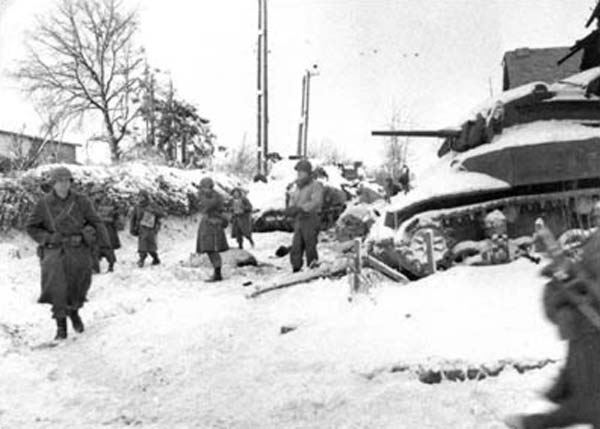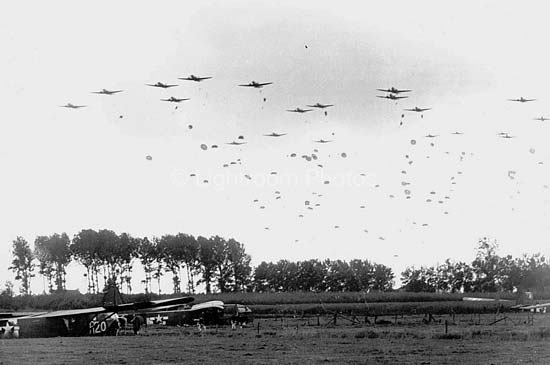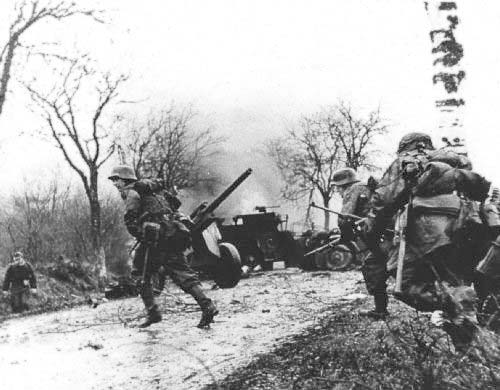| The Battle of the Bulge | |||||||
|---|---|---|---|---|---|---|---|
 |
|||||||
|
|||||||
| Contenders | |||||||
| Military Leaders | |||||||
(Supreme Allied Commander) |
|||||||
| Military Units in Battle | |||||||
| Beginning 83,000 men 242 medium tanks 182 other tracked AFV 394 artillery pieces 4 infantry divisions 1 armored division Reinforcements 20 infantry divisions 9 armored divisions On Dec. 23/24, 1944 610,000 men (average) 4,155 artillery pieces 1,616 medium tanks Aircraft: 6,000 |
Beginning 200,000 men 340+ tanks 280+ other tracked AFV 1,600 artillery pieces 955 rocket launchers 8 infantry divisions 5 armored divisions Reinforcements 12 infantry divisions 3⅔ armored divisions Reinforcements On December ~100,000 men 440+ tanks 440+ other tracked AFV Aircraft: 2,400 Total: 500,000 men | ||||||
| Casualties and Deaths | |||||||
89,500 (19,000 killed, 47,500 wounded, 23,000 captured or missing) ~800 tanks 1,408 (200 killed, 969 wounded, and 239 missing |
84,834 (other estimates range from 60-100,000)killed, missing/captured, or wounded Luftwaffe shattered ~600 tanks and assault guns Hundreds of aircraft |
||||||
| Part of World War II | |||||||
As even those with a passing knowledge of history will be aware of, there were scores of major battles fought during World War II. These battles raged across several continents. The battles were waged fiercely because winning one, single battle had the potential to shape the course of the war in a particular theater. In some cases, winning a battle could lead to changing the direction of the entire war.
The Battle of the Bulge was the only counteroffensive ordered by Hitler. The goal of this battle was to force the Allies into a position to sue for peace. In essence, this particular battle was sought by Hitler to be the ultimate game changer. He wanted the outcome of the battle to lead to the end of the war. As history shows us, Hitler and Germany did not succeed in their gambit. To some degree, the outcome of the battle may even have emboldened the Allies to continue to press forward and defeat the Axis powers.
Response to the D-Day Invasion
The Battle of the Bulge took place between December 16, 1944 and January 25, 1945. To a certain extent, it can be considered a response to an even more important battle that had impacted Germany in a devastating manner
 Among the greatest and most important battles of World War II was the Allied invasion of Normandy, France. The invasion was known as the D-Day invasion and it led to the liberation of France and a major change in the tide of the war.
Among the greatest and most important battles of World War II was the Allied invasion of Normandy, France. The invasion was known as the D-Day invasion and it led to the liberation of France and a major change in the tide of the war.
Hitler and the German army certainly were not ready to concede the war. Therefore, plans were set in motion to launch a counteroffensive that had as its goal a complete change in the tide of the war in the favor of Germany. The counteroffensive was launched on December 16 at the height of a very harsh winter. The attack by Germany would stretch through the Ardennes Mountains, which was located along the forests of Western Front in Belgium, and France and Luxembourg.
The Troops Stationed in the Region
About four divisions of Allied troops were stationed in this forest region. The troops were there primarily for rest, as the 75 mile stretch of forest was not considered for a high probability of battle. There were no roads. It was densely populated and the winter conditions were very harsh. That said, the region was not without strategic value. Pushing through the troops could help Germany eventually reach the English Channel which could have led an outright ground invasion of Great Britain.
 The German Army saw this as an opportunity for an easy victory and believed that the tide of the war could be swayed by such a victory. A massive offensive was set in motion where 200,000 German troops along with 1,000 tanks invaded the area, seeking to overtake the battle weary soldiers by surprise.
The German Army saw this as an opportunity for an easy victory and believed that the tide of the war could be swayed by such a victory. A massive offensive was set in motion where 200,000 German troops along with 1,000 tanks invaded the area, seeking to overtake the battle weary soldiers by surprise.
The Strategic Value of the Battle of the Bulge
The goal of the German Army was not to merely defeat the Allied troops located in the forests. The goal was also to break the Allied front lines that were protecting the Western Front. Maps of the Allied troops made them appear to bulge outwards and this colloquialism would contribute to the eventual nickname of the events that unfolded as the Battle of the Bulge. Splitting the American and British troops would have been a huge victory for Germany.
 The German troops were successful in their first day of battle and were able to greatly flummox the Allied troops. Germany’s brief victory was critical from a strategic perspective. The American front was broken and splintered after the first day of fighting. Major crossroads were captured and the Germany army was able to position itself so that it could continue an unabated forward march into the more populated areas of Belgium and France. Again, the Army felt it could once again reposition itself in such a way it could eventually overtake large segments of Western Europe.
The German troops were successful in their first day of battle and were able to greatly flummox the Allied troops. Germany’s brief victory was critical from a strategic perspective. The American front was broken and splintered after the first day of fighting. Major crossroads were captured and the Germany army was able to position itself so that it could continue an unabated forward march into the more populated areas of Belgium and France. Again, the Army felt it could once again reposition itself in such a way it could eventually overtake large segments of Western Europe.
Much of the civilian population was terrified of the German advance because they well remembered the devastation the German troops brought forth during successful invasions of 1940. The situation on the ground, however, had changed dramatically in 1945 and the German army was facing much tenacious opposition than it had in 1940.
The American Troops Go on the Offensive
The American troops did suffer major losses during the early days of the battle. However, the troops were able to hold off the German advance long enough so that reinforcements were able to reach the region by December 26. The goal of the German troops was to reach the Meuse River. They were stopped before they could actually reach it.
Also, on December 26, reinforcements reached the besieged American soldiers at Bastogne. The German attack did take many American casualties, but it was going to achieve its goals. In fact, when the full American reinforcements did reach the region, the German troops began to suffer massive losses. At the end of the Battle of the Bulge, 80,000+ American troops had been killed, but well over 100,000 German casualties had been suffered. At one point it did look bleak and the assumption was the German Army would come out of the Battle of the Bulge victorious. The main reason they did not was because the American troops were able to fight gallantly and prevent the onward march of the Germans before they reached their strategic goals.
To a great extent, the fighting spirit of the American troops along with the British helped prevent the tide of the war from changing. Instead, the events were a bitter loss for Hitler and a very demoralizing one. For the Allied troops, a great psychological and tactical victory was gained.
The Losses for Germany
Germany endured devastating losses. In addition to the massive casualties, the German reserves were no more, the aerial warfare wing of the German troops was equally devastated and the German Western Front Line soldiers were pushed even further back. In a very short time after this battle, the war would be over and Germany would be defeated.